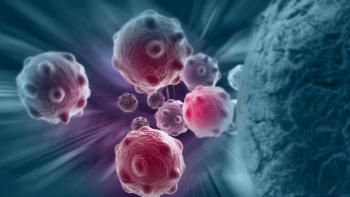
Evolving Role of Transplantation in Myelofibrosis
A comprehensive discussion on the respective role stem cell transplantation has in the treatment armamentarium for myelofibrosis.
Episodes in this series

Transcript:
John O. Mascarenhas, MD: Let’s pivot toward transplantation because that would be a modality to consider if you had a triple-negative patient and the outcomes are predicted to be worse. If they’re transplant eligible, you may refer that patient sooner rather than later. Andrew, who are the patients with MF [myelofibrosis] who you think are ideal transplant candidates? Are we optimizing our use of transplant or underutilizing transplantation?
Andrew T. Kuykendall, MD: It’s tough. With transplant, we know from the data that patients rarely undergo transplant, maybe 5% to 10%. Most of the patients we see are higher risk, and retrospectively we’re using DIPSS [Dynamic International Prognostic Scoring System] and things like that. As far as older prognostic models, it appears that transplant is a beneficial intervention for patients who have intermediate 2 and high-risk disease, at least when you look at a younger cohort of patients. That said, transplant is a big decision. It’s challenging for a group of patients who have a heterogeneous outcome. Even though we have 1 million prognostic models to try to tell us how these patients are going to do, we can’t say on an individual patient level with much certainty how that’s going to occur or how many good years patients are going to have before they don’t have any.
Timing of transplant becomes a huge challenge as well. The easiest group of patients who are great transplant candidates are young patients who are otherwise fit and have high-risk disease. But that’s a rare patient population. Unfortunately, our younger patients usually have the lowest-risk disease, and our older patients have the highest-risk disease. That’s where you come into a challenge with understanding what’s best for those patients. It’s an individual decision that you have to make with patients. Give them all the information that they can utilize to make such a decision. Oftentimes you have to bring in the transplanters, the medical oncologist, the hematologist, the patient, and their family, and figure out what their goals are moving forward. The recent data help us understand as much as possible what factors put patients at risk for having bad transplant outcomes. That’s something we’ve looked into over the past few years to try to understand.
We often mention ASXL1 as a high-risk mutation that might identify a patient who would be best to go to transplant. But unfortunately, in our transplant prognostic scoring systems, it’s also the mutation that predicts for not necessarily the best outcome after transplant. Just like TP53 mutations across MDS [myelodysplastic syndrome] and AML [acute myeloid leukemia], it’s hard to say “You have high-risk disease because of this mutation, so you should get an intervention.” That’s less likely to be effective because of the mutation that we sent you there for. That’s always a challenge. When you have cytogenetic abnormalities, which can predict for transformation into blast phase, that’s something that often makes me push a patient to a transplant earlier. If they have a disease that’s at high risk of transformation to an acute leukemia, which would make transplant difficult, that will make me push a patient toward transplant a little earlier.
One thing that came from ASH [American Society of Hematology Annual Meeting] last year is the impact that large spleens have on transplant outcomes. Unfortunately, with all our prognostic models, splenomegaly isn’t 1 of the factors that puts patients at higher risk for their disease, at least based on these models. We often aren’t too vexed by splenomegaly because we have various JAK inhibitors. Unfortunately, when those JAK inhibitors stop controlling spleen size, we may be in a position to put patients on a course for a transplant but then they’re stuck with JAK inhibitor–resistant massive splenomegaly, which puts them at bad outcomes for transplant. In some ways, we should consider this earlier and send most patients for at least a transplant consultation. If they’re young and otherwise healthy and motivated, we should it consider earlier. But I probably have more questions than answers when it comes to transplant timing.
John O. Mascarenhas, MD: I agree. There are often a lot of conflicting data about the impact of mutations and transplant outcomes. A lot of it depends on the data sets utilized, the median ages of those patients who went into transplant, and the types of conditioning regimens. We still haven’t optimized the implementation of transplant for MF patients. A lot of it is because there’s such heterogeneity in the clinical and biological features of these patients. I have a specific question for Gabby. Let’s say you have an accelerated phase patient, with circulating blasts of 12% in the peripheral blood or in the bone marrow. Do you and your transplant colleagues want to site reduce those patients before transplant? Or do you get them right into their transplant with the circulating blasts?
Gabriela S. Hobbs, MD: Good question. On paper, transplant doctors often want to see some site reduction. It also has to do with what’s going on with the patient and what else is going on other than the 12% blasts. We’ve all seen patients who come in 1 day with 12% blasts, the next day with 2% blasts. They fluctuate wildly. It’s a matter of seeing what’s going on in the bone marrow and what other mutations that patient has. Does that patient also have splenomegaly and things that correlate with worse outcome after transplant? But at least 1 or 2 cycles of some cytoreductive therapy, whether that’s a hypomethylating agent by itself or adding some venetoclax, is something we’d consider for that type of patient prior to going to transplant.
John O. Mascarenhas, MD: Kristen, in Michigan, do the transplanters want a certain spleen volume or spleen length before they take the patient to transplant?
Kristen M. Pettit, MD: Yes. It’s such a controversial topic, and I always going back and forth about this. We have good data that, the earlier we transplant patients and the lower the grade of disease and smaller the spleen, the better they do overall. Does that mean that we should be shooting for no spleen or as a small of a spleen as possible before transplant? Does that improve things? Or does the risk of splenectomy outweigh the potential benefit? I don’t know the answer to that. There’s a trial going on trying to answer that question. Hopefully, we’ll have some more guidance. We’re going on retrospective observational data.
The approach that my center has come up with—between myself, our MPN [myeloproliferative neoplasm] group, and our transplant group—is to do everything we can to try to shrink the spleen before transplant as much as possible, to optimize a patient for transplant. I do that at the expense of blood counts for some patients. In that situation, I’ll accept a bit more anemia and thrombocytopenia if we have the goal of getting the patient to transplant with as small of a spleen and as good of disease control as possible. For patients with massive spleens, we do splenectomies before transplant occasionally. It’s not common. Our very soft cutoff has been a spleen size by imaging of about 20 cm. We’ve made exceptions on both sides of the spectrum, but I hope we have more hard data soon.
Transcript edited for clarity.
Newsletter
Stay up to date on recent advances in the multidisciplinary approach to cancer.






















































































